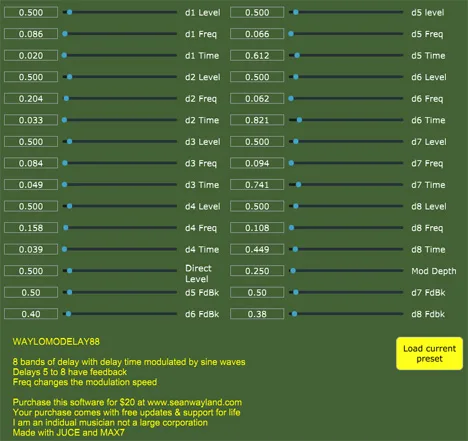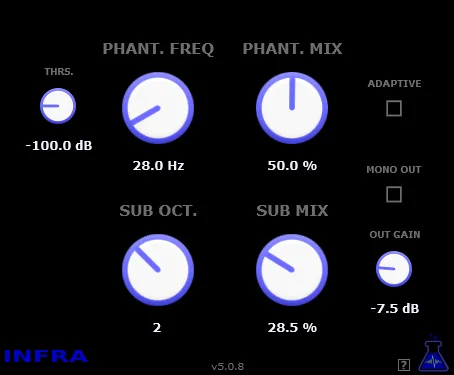Waylomodelay88: New Horizons of Modulation Effects
In the world of sound design and music production, modulation effects play a key role, adding movement, depth, and a unique character to any audio signal. From the classic choruses that make the sound wider and richer, to the psychedelic phasers that create whimsical overtones and a sense of space, these tools are indispensable in the arsenal of any musician or sound engineer.
The Waylomodelay88 plugin from the talented developer Sean Wayland offers a fresh look at modulation, combining the principles of delay and low-frequency modulation to create rich chorus and phaser effects. This is not just another standard plugin, but a flexible tool that allows you to dive deep into the world of modulation and experiment with sound, opening up new textures and spatial dimensions for your tracks.
Delay-Based Architecture: The Heart of Waylomodelay88
At the heart of Waylomodelay88 lies a unique architecture consisting of eight independent delay lines. This is significantly different from many classic modulation effects, which may use fewer delays or other phase processing principles. The presence of eight separate “delay heads” gives the developer and the user extraordinary flexibility in shaping the sound. Each delay line can be individually adjusted in terms of delay time, modulation depth, and feedback level (for the last four), allowing you to create complex and multi-layered modulation textures that would be difficult or impossible to obtain with simpler plugins.
It is the interaction of these eight delays, their precise tuning, and dynamic modulation that create a rich spectrum of effects, from subtle and barely noticeable, which only add “glue” to the mix, to extreme and experimental, which can completely change the character of the original signal.
Breathing Sound: Low-Frequency Modulation
A key element that “animates” the delays in Waylomodelay88 is the built-in low-frequency oscillator (LFO), which generates a sinusoidal signal. This oscillator does not modulate volume or filter, as is often the case, but dynamically changes the delay time of each of the eight lines.
How does it work?
The delay time for each line constantly fluctuates smoothly around a set base value. The range of this fluctuation is determined by the “modulation depth” parameter. For example, if the base delay is set to 100 milliseconds and the modulation depth is 2 milliseconds, then the actual delay time for this line will cyclically change between 98 ms and 102 ms according to the sine wave. The rate of this oscillation (the LFO frequency) determines the “speed” of the effect – from slow, “floating” textures to a fast, trembling vibrato-like sound at very short delays.
This constant, barely noticeable change in delay time causes the Doppler effect in the audio signal – when the delay becomes shorter, the pitch seems slightly higher, and vice versa. When several such modulated copies of the original signal are mixed together, the characteristic “detuning” and “thickening” of the sound characteristic of the chorus occurs, imitating the sound of several instruments or voices playing or singing simultaneously with small differences in time and pitch. Using very short delay times in combination with moderate modulation is a classic way to get a rich chorus effect, and Waylomodelay88 implements this principle at a high level thanks to its multi-band architecture.
Feedback Power: From Echo to Phase Shifts
A special feature of Waylomodelay88, which extends its functionality far beyond a simple chorus, is the presence of adjustable feedback for the last four delay lines (from the 5th to the 8th). Feedback allows you to feed part of the output signal of the delay back to its input, creating a regeneration effect.
How feedback works:
-
At low feedback values, the delay repeats gradually fade, creating an effect similar to a short echo or reverberation, adding a “tail” to the modulation effect.
-
As the feedback value increases, the repetitions become louder and longer. If the feedback level reaches or exceeds 100%, the repetitions can last indefinitely, creating self-excitation or a “freeze” effect on the sound.
-
At very short delay times (in the millisecond range) and the presence of feedback, the effect begins to resemble a flanger or phaser. Although phasers usually work on a different principle (phase shift using filters), the use of modulated delays with feedback can imitate the characteristic comb filter effects associated with phasing, adding metallic or “reactive” tones.
This feature adds another level of control and flexibility, allowing you to create both soft and transparent modulations and more intense ones bordering on delay, flanger or even synthesis effects. By combining modulation and feedback, you can get dynamic, evolving textures.
Spatial Placement: Stereo Panning
To enhance the stereo effect and add a spatial dimension, the delays in Waylomodelay88 are alternately panned left and right. This is a simple but effective technique for expanding the sound across the stereo base. Usually, one half of the delay lines (e.g. 1, 3, 5, 7) is sent to the left channel, and the other (2, 4, 6, 8) – to the right. This alternation creates a sense of movement and volume, making the chorus or phaser even more voluminous and immersive, especially when listening through headphones or a stereo system. This helps to isolate the processed instrument in the mix, giving it space and presence.
Practical Application: From Traditions to Experiments
Sean Wayland, the plugin’s developer, himself suggests a typical and effective scenario for using Waylomodelay88: combining four short delays (with minimal or no feedback) to create a classic, dense chorus effect, and four longer delays (using adjustable feedback) to add texture, atmosphere or even rhythmic repetitions. This approach demonstrates how the plugin’s flexible architecture allows you to mix different types of modulation and delay in a single instance, creating complex combined effects.
Waylomodelay88 is a versatile tool that can be used to process a wide range of audio materials:
-
Guitars: From a light chorus for acoustic parts to a deep, floating sound for electric guitar arpeggios or riffs. You can also experiment with phaser textures.
-
Keyboards and Synthesizers: Adding warmth, movement and stereo width to pads, leads, basses or arpeggios. Creating complex, evolving textures.
-
Vocals: Obtaining the effect of a “double” or “triple” voice, creating flowing vocal harmonies, or adding atmospheric space.
-
Drums and Percussion: To create experimental rhythmic effects, add “body” to individual elements of the drum kit or form unique percussion textures.
-
Sound Design: Creating unusual, moving sound effects for movies, games or audio installations.
Compatibility and Availability
The Waylomodelay88 plugin is designed with broad compatibility with modern working environments. It is available in the popular VST and AU formats, ensuring its seamless integration with the vast majority of digital audio workstations (DAWs) such as Ableton Live, Cubase, Logic Pro, FL Studio, Pro Tools, and many others. The plugin supports operation on Windows (for 64-bit versions) and macOS operating systems, making it available to a wide range of users regardless of their platform.
Waylomodelay88 is more than just a chorus or phaser plugin. It is a tool for in-depth exploration of modulation, allowing you to create unique and complex soundscapes by combining the principles of delay, modulation and feedback. Its flexible architecture with eight delay lines and an intuitive approach to modulation make it a powerful addition to the arsenal of any music or sound creator. Try Waylomodelay88 to add new colors, movement and spatial dimensions to your music compositions and sound design.



